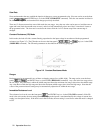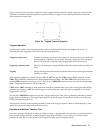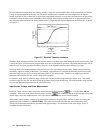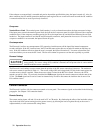
30 Operation Overview
Input On/Off
A load’s input can be toggled on/off at the front panel (
key) or via the GPIB (INPUT ON|OFF command).
The input on/off change does not use the slew rate setting so the input will change at the maximum slew rate.
Turning the input off (zero current) does not affect the programmed settings. The input will return to the previously
programmed values when the input is turned on again. Note that the Input On/Off command supersedes the mode
commands and Short On/Off command.
Saving and Recalling Settings
The Electronic Load has internal registers in which settings (mode, current, voltage, resistance, slew, transient level, etc.)
for various tests can be stored. Saving settings and recalling them later saves programming time.
The present settings are saved in the specified register (0 to 6) at the front panel (
key) or via the GPIB (*SAV
command). All of the settings are saved in the specified location in the load’s memory. Settings saved in locations 1
through 6 will be lost when ac line power is cycled. However, the *SAV 0 command will cause the settings to be stored in
non-volatile memory; and, the next time the Electronic Load is turned on, these settings will become the power-on settings.
You can recall the saved settings from the specified register (0 to 6) at the front panel (
key) or via the GPIB (*RCL
command). All of the parameters that were saved by the *SAV command are set to the saved values. At power-on, the
Electronic Load automatically executes a *RCL 0, which recalls the values saved in nonvolatile memory.
You can recall the factory default settings at the front panel (
) or via the GPIB (*RST command).
Reading Remote Programming Errors
Remote programming errors can be read via the GPIB (SYST:ERR? query) or at the front panel (
key). The Err
annunciator indicates when remote programming errors have occurred. The errors are negative numbers grouped into
blocks of 100 as follows:
-lxx Command errors
-2xx Execution errors
-3xx Device-specific errors
-4xx Query errors
The SYST:ERR? query (or
key) reads back the errors in the order in which they occurred (the error queue can hold
up to 30 entries). Once the error is read back it is removed from the list. A value 0 indicates there is no error; and 0 will be
returned when all errors in the list have been read. Pressing the
key displays just the error number. The
SYST:ERR? query returns the error number and a short description of the error to the computer. Refer to Chapter 6 in the
Agilent Electronic Loads Programming Reference Guide.
Local programming errors generated by front panel operations are not put into the error list, but are immediately put on the
Electronic Load's front panel display; e.g., 'OUT OF RANGE'.
Status Reporting
The Electronic Load incorporates a status reporting capability. Various status conditions within the Electronic Load can be
reported using this capability. The user determines which condition will be reported. Chapter 5 of the Agilent Electronic
Loads Programming Reference Guide describes the status reporting capability in detail. Note that for a Single Input
Electronic Load, the same information is available in both the channel status and questionable status registers.


















